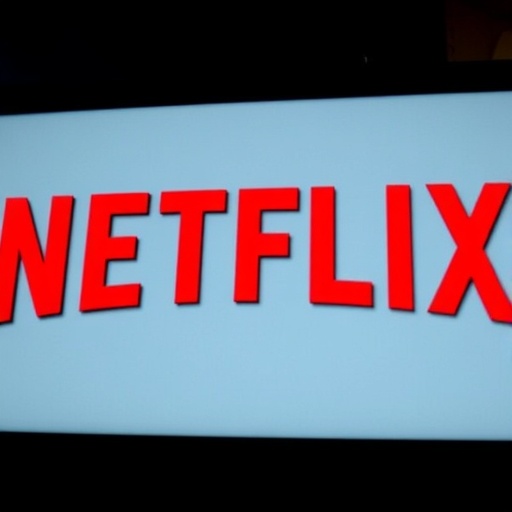Netflix Stock Tumbles 6% After Shock Earnings Miss from $619 Million Brazilian Tax Dispute
In a stunning blow to investors, Netflix shares plunged 6% in after-hours trading on Wednesday following the company’s first-quarter earnings report that revealed an unexpected shortfall. The streaming giant, long a Wall Street darling, attributed the miss primarily to a staggering $619 million expense tied to a long-simmering tax dispute in Brazil. This revelation has sent shockwaves through the entertainment sector, raising questions about Netflix‘s international expansion strategy and its ability to navigate regulatory hurdles in key emerging markets.
Netflix, which reported earnings per share of $5.28 against analyst expectations of $5.71, saw its stock drop from a closing price of $682.36 to around $641.82 in extended trading. The earnings miss marks a rare stumble for the company, which has consistently beaten Wall Street forecasts in recent quarters amid aggressive growth in subscriber numbers and ad-supported tiers. However, the one-time charge related to Brazil overshadowed otherwise solid performance metrics, including a 9% year-over-year revenue increase to $9.37 billion.
The Brazilian tax issue stems from a dispute over content licensing rights and withholding taxes that Netflix has been contesting for years. In its earnings call, CFO Spencer Neumann described the expense as a “non-recurring item” but warned that similar challenges could arise in other markets. “We’re committed to resolving these matters efficiently, but they highlight the complexities of operating in diverse regulatory environments,” Neumann stated.
Unraveling the $619 Million Brazilian Tax Bombshell
The heart of Netflix’s earnings miss lies in Brazil, a market that has become a cornerstone of the company’s global ambitions. Brazil boasts over 20 million Netflix subscribers, making it the streaming service’s largest market in Latin America. However, the country’s tax authorities have long scrutinized foreign streaming platforms, accusing them of underpaying taxes on digital content distribution.
The $619 million charge represents a settlement or provision for back taxes, penalties, and interest accrued from disputes dating back to 2016. According to Netflix’s SEC filing, the expense covers “unfavorable outcomes in tax litigation” related to the classification of streaming revenues as taxable services versus royalty payments. Brazilian law requires foreign companies to withhold taxes on payments to overseas content providers, a rule Netflix argued did not fully apply to its subscription model.
Experts familiar with the case point to a landmark 2022 Brazilian Supreme Court ruling that classified streaming services as taxable entities, paving the way for aggressive audits. “This isn’t just a Netflix problem; it’s an industry-wide headache,” said Maria Silva, a tax attorney specializing in media at the firm Deloitte in São Paulo. “Platforms like Netflix have been fighting these battles since entering the market, but the sheer scale of the charge underscores how high the stakes are for digital giants.”
Netflix’s Brazilian operations have been a double-edged sword. On one hand, the country has driven subscriber growth, with Netflix adding 1.2 million users there in the last quarter alone. On the other, regulatory pressures have escalated. The company has invested heavily in local content, producing hits like 3% and Narcos: Mexico, which often feature Brazilian talent and settings. These investments, totaling over $1 billion since 2018, were meant to foster goodwill and compliance, but the tax dispute suggests otherwise.
Financially, the hit is significant. The charge wiped out nearly 40% of Netflix’s projected quarterly profit, turning what could have been a blowout quarter into a cautionary tale. Without it, adjusted earnings would have exceeded expectations by 12%, analysts estimate. This one-off expense also inflated Netflix’s effective tax rate to 28% for the quarter, up from 25% a year ago.
Broader implications for Brazil include potential ripple effects on other U.S. tech firms. Amazon Prime Video and Disney+ face similar scrutiny, with reports of ongoing audits in the region. “If Netflix’s settlement sets a precedent, we could see a wave of liabilities across the streaming sector,” warned Silva.
Netflix’s Core Metrics Shine Despite the Tax Shadow
Beneath the tax turmoil, Netflix’s operational engine hummed along impressively. The company reported 277.6 million global paid subscriptions, a 9% increase from the previous year, surpassing forecasts of 276.5 million. This growth was fueled by crackdowns on password sharing, which Netflix estimates converted 13 million sharers into paying users in the quarter.
Revenue climbed to $9.37 billion, up 15% year-over-year, driven by price hikes in mature markets like the U.S. and a surge in ad-tier adoption. The ad-supported plan, launched in late 2022, now accounts for 40% of new sign-ups in eligible regions, generating $1.2 billion in incremental revenue. “Our focus on multiple revenue streams is paying off,” CEO Ted Sarandos said during the earnings call. “Ads are not just a buffer; they’re becoming a core pillar.”
Geographically, performance was mixed. North America added 1.2 million subscribers, while Europe, Middle East, and Africa saw a robust 3.1 million additions. Latin America, including Brazil, contributed 1.8 million, but the region’s growth was tempered by economic headwinds like inflation and currency devaluation. Asia-Pacific lagged with just 800,000 new users, highlighting challenges in competing with local players like iQiyi in China.
Content spending remains Netflix’s superpower, with $17 billion allocated for 2024 on originals and licensed fare. Highlights include the blockbuster success of Squid Game Season 2, which drew 150 million viewing hours in its debut week, and upcoming releases like Stranger Things final season. These investments have boosted engagement metrics, with average daily viewing time up 12% to 2.1 hours per subscriber.
Yet, the earnings miss exposed vulnerabilities. Operating margins dipped to 22% from 24% last year, partly due to the tax charge but also rising content amortization costs. Free cash flow, a key investor metric, came in at $2.8 billion, slightly below expectations amid higher marketing spends to promote the ad tier.
- Subscriber Growth: 277.6 million total, +9% YoY
- Revenue: $9.37 billion, +15% YoY
- EPS (Adjusted): $5.28 vs. $5.71 expected
- Content Spend: $4.2 billion in Q1
Analysts like those at JPMorgan note that while the tax issue is painful, Netflix’s fundamentals remain robust. “This is a speed bump, not a derailment,” wrote analyst Alexia Quadrani in a research note.
Wall Street’s Frenzied Response to Netflix’s Stock Drop
The 6% stock drop was swift and severe, erasing $25 billion in market cap overnight. Pre-earnings, Netflix shares had surged 45% year-to-date, buoyed by optimism around live events like the upcoming NFL games and WWE partnership. Post-earnings, volatility spiked, with trading volume tripling the average.
Investor sentiment soured on fears that the Brazilian dispute signals deeper international risks. “Emerging markets are Netflix’s growth engine, but they’re also a minefield,” said Wedbush Securities analyst Daniel Ives. “This $619 million is a wake-up call for how taxes and regulations could erode margins.” Ives maintains a buy rating but trimmed his price target from $750 to $720.
Options trading reflected the unease, with put volume surging 200% as traders bet on further downside. Hedge funds, which hold 15% of Netflix’s float, reportedly initiated short positions, citing overvaluation at a forward P/E of 35x.
Comparisons to peers underscore the pressure. Disney’s stock, down 10% YTD, has faced its own streaming woes, but its diversified portfolio cushions blows. Amazon, with Prime Video bundled into its e-commerce empire, reported stable earnings without similar tax drama. Netflix’s pure-play model amplifies such hits, making the stock drop a stark reminder of its exposure.
Social media buzz amplified the fall, with #NetflixEarnings trending on X (formerly Twitter). Users vented frustration over recent price hikes, while memes mocked the “Brazilian plot twist” in Netflix’s financial narrative. Retail investors, via platforms like Robinhood, sold off 2% of their holdings, per data from Vanda Research.
Longer-term, the drop positions Netflix shares at a relative discount. At current levels, the stock trades at 28x trailing earnings, below its five-year average of 32x. Value hunters may see opportunity, especially with Q2 guidance calling for 5 million net adds and $9.5 billion in revenue.
Navigating Global Regulations in the Streaming Era
Netflix’s Brazilian tax saga is symptomatic of a broader clash between U.S. tech behemoths and international regulators. As streaming overtakes traditional TV, governments worldwide are clamping down on digital taxes to capture revenue from borderless services.
In Europe, the EU’s Digital Services Act imposes fines up to 6% of global revenue for non-compliance on content moderation. Netflix has ramped up lobbying, spending $2.5 million in 2023 on D.C. advocacy alone. In India, a 2023 levy on streaming ads has squeezed margins, while Australia’s proposed news bargaining code could force payments to local media.
The Brazilian case, however, stands out for its scale. It echoes Amazon’s $500 million French tax settlement in 2020 and Google’s €1 billion Irish back-tax payment. For Netflix, which derives 60% of revenue from outside the U.S., such disputes threaten its 20% annual growth trajectory.
Strategically, Netflix is diversifying. The company has localized more content—85% of viewing hours now come from non-English titles—and partnered with local telcos for bundled offerings in Brazil and India. Sarandos emphasized this in the call: “We’re not just streaming; we’re embedding in cultures to build sustainable growth.”
Competitive dynamics add pressure. With Disney+ launching ad tiers and Warner Bros. Discovery merging Max with Discovery+, the streaming wars are intensifying. Netflix’s first-mover advantage in ads gives it an edge, but tax liabilities could force price adjustments, alienating cost-sensitive subscribers in emerging markets.
Industry watchers predict more turbulence. A PwC report estimates global digital taxes could extract $50 billion annually from tech firms by 2025. For Netflix, proactive compliance—perhaps through in-country subsidiaries—may be the key to averting future misses.
Charting Netflix’s Path Forward Amid Uncertainty
Looking ahead, Netflix’s resilience will be tested. The company reaffirmed full-year guidance of 18-20 million net adds and $15 billion in free cash flow, excluding one-offs. Q2 earnings, due in July, will be pivotal, with focus on ad revenue ramp-up and live sports integration.
Innovations like gaming expansion—Netflix now offers 80 titles with 23 million monthly users—and AI-driven personalization could offset regulatory drags. The WWE deal, starting in 2025, promises $5 billion in annual value, bolstering content appeal.
Investor confidence hinges on execution. If Netflix can resolve lingering disputes and sustain subscriber momentum, the stock drop could prove a buying opportunity. Analysts project 12% revenue growth in 2025, with EPS climbing to $23.50. However, persistent tax woes might cap upside, prompting calls for a more conservative international footprint.
For consumers, the impact may be subtle: potential price tweaks or ad load increases to recoup costs. Yet, Netflix’s dominance—commanding 50% of U.S. streaming time—suggests it will endure. As Sarandos put it, “Challenges like this sharpen our focus on what matters: delivering joy to members worldwide.” The road ahead is bumpy, but Netflix’s story is far from over.










